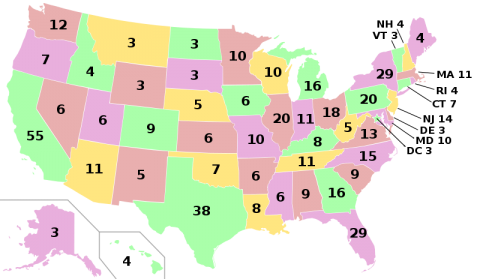How the Electoral College Works

By: Roger Morris
Some of you may be saddened hear that the presidential election will not be decided on Tuesday, November 8th but actually on December 19th. This does not mean that you will have to put up with another month and a half of campaign ads and generally saddening news coverage. December 19th is when the Electoral College meets and casts the 538 electoral votes that really decide who the 45th President of the United States will be.
As you watch election night coverage, I am sure you will hear media commentators discuss the national popular vote, and how it impacts the election. However, the national popular vote means nothing when it comes to electing our next President. As recently as 2000, the winner of the popular vote ended up losing the Electoral College vote. This scenario has happened three other times in our nation’s history: 1824, 1876, and 1888. This doesn’t make any sense, right? Shouldn’t the person with the most votes win the election?
Not necessarily. Instead, the Electoral College elects our President and Vice President. When you go to cast your vote for President, you aren’t really voting for your candidate. You are voting for electors who will cast your state’s electoral votes in December. The Electoral College is the name for the 538 electors who vote to decide who the winners are. You may be wondering who these electors are and how they are chosen. The process varies from state to state, but generally each political party in your state will nominate slates of potential electors at state party conventions or choose them by a vote of the party’s central committee. These people are usually state party officials, elected officials, or others who have a political or personal affiliation with that political party. If Hillary Clinton were to win your state, then the electors chosen by your state’s Democratic Party would cast your state’s electoral votes. If Donald Trump were to win your state, then the electors chosen by the Republican Party in your state would cast your state’s electoral votes.
The number of electors in a state is calculated by adding the two senators your state has to the number of your state’s members of the House of Representatives, which is determined by population. In Kentucky, we have two Senators (like every other state) and six Representatives (apportioned based on our state’s population), bringing our total to eight. If Donald Trump wins Kentucky like the polls suggest, then the eight electors our state’s Republican Party selected would cast our state’s 8 electoral votes. The electors vote on the first Monday after the second Wednesday in December. This is the date the Electoral College meets according to federal law. In 2016, this date falls on December 19th. Each state’s electors will meet in each of their respective states on that date to cast their votes. The electors will go through two rounds of voting: one to select the President and the other the Vice President.
The mode of appointing electors is exclusively reserved to the states by the Constitution. As a result, states can decide how they want to bind their electors. Most states commit all of their electors to the winner of the state popular vote. Maine and Nebraska do things a little bit differently. These states will cast two electoral votes to whichever candidate wins their state’s popular vote. The rest of Nebraska’s electoral votes are allotted based on whoever wins each of Nebraska’s 3 congressional districts. Polls suggest that Republican candidate Donald Trump will win the popular vote in Nebraska, so he will earn two electoral votes that way. To earn the other three electoral votes, Mr. Trump would have to win a majority of the vote in each of the three congressional districts. Polls suggest that Nebraska’s 2nd congressional district, which includes the state’s largest city Omaha, is closely contested, and this could provide Hillary Clinton with one electoral vote even though she will likely lose the state’s popular vote. This scenario actually occurred in 2008 in Nebraska, with Barack Obama winning one of the state’s Electoral College votes by winning the 2nd congressional district.
Maine allocates its electoral votes the same way, with two for the statewide winner and two others based on congressional districts. Trump is polling well in Maine’s 2nd congressional district. With the race tightening in the last few weeks, these individual electors could prove pivotal if the race is close.
Adding up the number of Senators (100) and Representatives (435) in the 50 states gives us a total of 535. DC also receives 3 Electoral College votes under the 23rd amendment, even though it has no voting representative in Congress. To win the election a candidate must win at least 270 electoral votes, or a majority of the Electoral College. Of course 538 is an even number, which means there is a possibility of a tie of 269-269. This has never happened and is an unlikely scenario, but it is not impossible.
If a candidate wins at least 270 votes on December 19th, 2016 when the Electoral votes are cast, then the election will be verified by Congress on January 6 and the winning candidate will take the oath of office on January 20th, 2017 to become the 45th President of the United States. What happens if a candidate does not reach 270? We will consider that possibility in another post.
